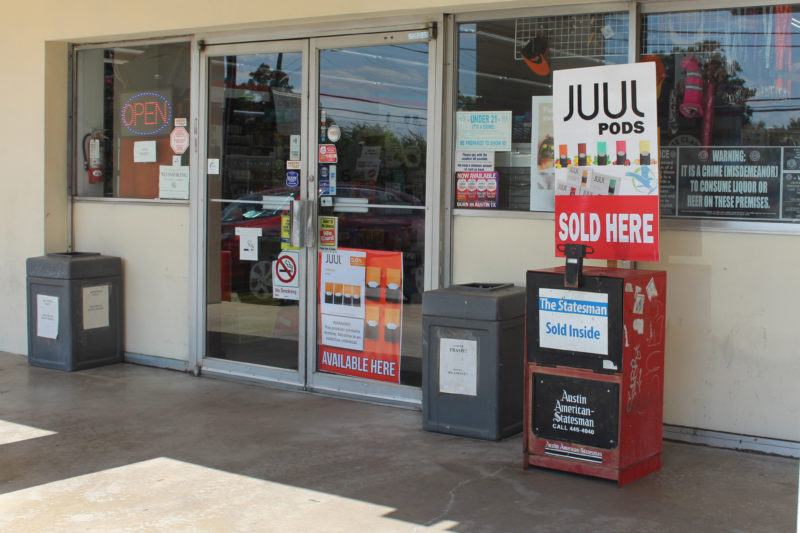JUUL’s Marketing Scrutinized As Vaping Injuries, Deaths Rise
By Madelyn Reiter
Reporting Texas TV

E-cigarette companies, including leading brand JUUL Labs, have sold their products as less harmful alternatives to smoking traditional tobacco, but questions about the safety of vaping are killing the marketing message.
Vaping has come under greater scrutiny by politicians, regulators and the public, especially with an outbreak of severe vape-related lung diseases and even deaths. The Centers for Disease Prevention and Control reports there have been more than 500 cases across the country, including at least a dozen deaths. Although the CDC does not yet know the exact causes of the illnesses, all cases have involved the consumption of either nicotine, THC and/or CBD by vape. Data on 373 of the 530 cases shows 18 to 34-year-olds are the most affected group, making up two-thirds of cases.
The Food and Drug Administration released a warning to JUUL in early September against using unsupported scientific claims in its marketing. However, JUUL’s official mission to “improve the lives of the world’s one billion adult smokers by eliminating cigarettes” remains.
Though cigarette sales have declined since JUULs’ launch, according to JUUL Labs Inc. former CEO Kevin Burns, critics are skeptical of the $38 billion dollar company.
“The thing with JUUL is there is kind of a pre-and post JUUL when the FDA became more involved,” said Keryn Pasch, director of the Health Behavior and Health Education program at the University of Texas.
“Before, its advertising was very youth oriented. If you look at some of their ads, they use really bright colors and they’re very focused on youth images, but after facing scrutiny, the company knew it had to make changes.”
Co-founders and former cigarette smokers James Monsees and Adam Bowen launched JUUL in 2015. The electronic vaping device resembles a USB memory stick and contains a concentrated amount of nicotine — 59 mg/ml — making the product highly addictive, states a report by BMJ Journal. JUUL represented 76% of the entire e-cigarette market by November 2018, according to Nielsen data.
Young adults and teenagers may be the driving factor behind the company’s growth and economic success. The CDC found that e-cigarette use among American high school students reached 21% in 2018 — a 78% increase from the previous year. Furthermore, a CDC survey of over 14,000 young adults and teens shows 15 to 17-year-olds are 16 times more likely to use JUULs than 25 to 34-year-olds.
JUUL and other vaping products prominently displayed at the entrance to a convenience store frequented by University of Texas students
Emily Berke, a senior at the University of Texas said she started using JUULs at 17. She would occasionally ask her friends for a “rip” of their JUULs at parties, she said. A year later, she legally purchased her own at local convenience store Orange Market.
“I looked cool and I got a nice buzz,” Berke said. “I tried to quit this past summer because I’d get chest pains, but everyone in my office — including my bosses — were JUULing all day, so I fell back into my habit to fit in.”
Stanford University research points to JUUL’s digital advertising and marketing strategies as the reason it “achieved a cult level of popularity among school aged adolescents.”
“Social media removes that ‘marketed by JUUL’ or ‘marketed by Marlboro’ or ‘Philip Morris’ statement,” Pasch said. “It’s almost insidious marketing in a way because they don’t even realize they’re being marketed to.”
JUUL recently announced it has suspended its advertising in print, broadcast and digital.
The company had spent more than $200,000 on marketing and sponsorships targeted at young people, according to a U.S. House subcommittee. JUUL has advertised on social media platforms frequented by the youth and has partnered with social media influencers and affiliates. Within a three year period, starting in October 2015, JUUL posted 40 advertisements for mango flavored JUUL pods alone across Twitter, Facebook, Instagram and email.
“Youth is a particularly vulnerable time because the youth are trying to figure out a lot of things about themselves and who they are,” Pasch said. “Social media is a place where they can go to see what other people are doing, and it may not reflect anyone’s reality, but it allows you to reflect on who you want to be.”
JUUL’s early “Vaporized” campaign featured trendsetting attractive 20-something models and fun youthful colors. Its slogan, “smoking evolved,” also taps into youth culture by associating the product with high technology and next generation chicness. The company continues to incorporate youth values, including pleasure, socialization, romance and style into its advertisements.
Adolescents are not the best decision makers, Pasch explained. When they are confronted by these visual advertisements, they don’t actively or cognitively process them, but the messages of happiness become imprinted in their minds, making them more likely to be interested in using the e-cigarette.
These advertising strategies resemble those of big tobacco companies. For example, American Spirit used colors to symbolize youth, Newport employed models in their 20s to emulate playfulness and Camel shared messages of relaxation and pleasure.
“So much technology and tools have changed, but advertising appeals haven’t,” said advertising professor at the University of Texas and former tobacco company consultant, Gary Wilcox. “You and I still have the same need for love, security, prestige and novelty that people had 40 years ago.”
Tobacco companies have been limited in their advertising since 1970 when then-President Richard Nixon signed the Public Health Cigarette Smoking Act, which banned cigarette advertisements from broadcasting over mass media. The diminishing presence of cigarettes in the media and the rise of the anti-smoking campaign have caused cigarette sales to decline. However, these big tobacco companies are adapting and getting behind the e-cigarette movement. For example, tobacco giant Altria, which owns Marlboro cigarettes, acquired a 35% stake of JUUL in 2018.
“Marlboro marketers are probably the smartest marketers I’ve ever been around,” Wilcox said. “It’s hard for the government to catch up to a smart marketer.”
Whether federal regulations and restrictions on e-cigarette advertising will follow a similar trajectory to cigarette advertising is unknown. The government is, however, cracking down on the e-cigarette youth epidemic.
 JUUL Labs Inc. has leased 62,700 square feet of office space in this new building on South Lamar in Austin. The Austin Business Journal reported the move represents the company’s first step in a significant expansion for the San Francisco-based vaping start-up.
JUUL Labs Inc. has leased 62,700 square feet of office space in this new building on South Lamar in Austin. The Austin Business Journal reported the move represents the company’s first step in a significant expansion for the San Francisco-based vaping start-up.
“While we remain committed to advancing policies that promote the potential of e-cigarettes to help adult smokers move away from combustible cigarettes, that work can’t come at the expense of kids,” FDA Commissioner Scott Gottlieb said during a speech at the agency’s headquarters.
JUUL initially responded to public backlash by pivoting its marketing strategies. The brand’s latest campaign, “Make the Switch,” emphasized the value of e-cigarettes as a healthier alternative to traditional cigarettes. Unlike its earlier advertisements, JUUL steered away from the image of vaping being cool and fun. Rather, it tapped into consumers’ emotional connections.
“Make the Switch” advertisements were often in print or aired on television or radio. According to NPR, the campaign was a $10 million investment for the company in an effort to reach an older generation. JUUL’s most recent advertisements aligned with its mission statement to help traditional smokers find an alternative, but it raises questions about the brand’s authenticity.
“They’re probably spending so much on print advertising in newspapers now, so they can hold up that defense,” Wilcox said, shortly before JUUL suspended its advertising. “They want to be able to say ‘Well in the last year we’ve spent 80% of our budget trying to get people to convert.’”
Social Media Video By Kyle Maddry
A visual comparison between modern-day JUUL advertisements and cigarette advertisements of decades past